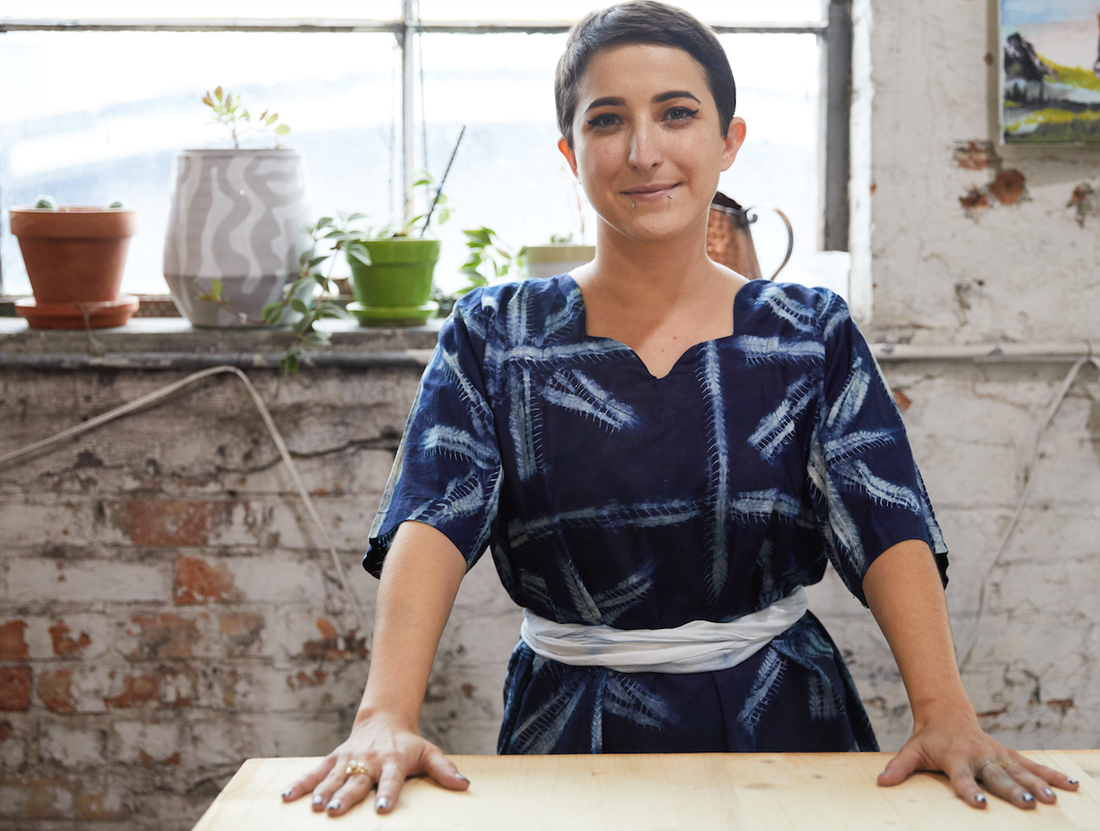When starting the design process for our first collection at The Materials Design Co I knew I had to connect with textile artist Amy Taylor, who specializes in natural dyes and pigments. We had met several years ago on individual artist residencies with Arquetopia in Oaxaca, Mexico, and have kept in touch since. We collaborated on this first collection to create beautiful indigo canvas which Amy expertly dyed by hand in her Chicago studio, and which is now included in some of the most outstanding pieces on our site.
Now that the first collection is in production, I interviewed Amy to find out more about her background and love of the natural dyeing process.
Arielle: As I have discovered throughout the design process, there is such a learning curve when it comes to natural dyes, and so much to know! When did you first learn about natural dyes?
Amy: I saw some instructors do natural dyes in school, but didn't really begin to learn about them on my own until after graduation. I had been learning and experimenting with synthetic dyes, but I eventually hit a wall when I realized the recipes are all the same. Natural dyes were the next step in learning about dyeing, and I was drawn to the challenge. There was so much to learn, I started blindly following my instructor's recipes and I really didn't understand why I was doing what I was doing. Through time, practice, and a lot of failure and success I've fallen in love with the chemistry, the history, and the cultural importance of natural dyes.
Arielle: You are clearly so passionate about the process, what makes you feel so strongly about it?
Amy: There are lots of reasons why I love natural dyes, but one of my favorite elements is that I can (and will) spend the rest of my life studying them, and there will always be more to learn. Natural dyes were the only dyes available until 1856, so it blows my mind that every culture, every society, every corner of the world throughout history developed their own methods and materials for transferring pigment to fabric. Entire economies were built and destroyed based on natural dyes, wars were fought over natural dyes; learning the hows and whys of these pigments makes me feel connected to history.
Arielle: I love the historical aspect! Chemical dye technology was so revolutionary and changed the world of fashion and interiors drastically, but there is something inherently special about creating color from nature. What are the challenges of using natural pigments rather than chemical dyes?
Amy: One of the main challenges of using natural pigments rather than chemical dyes is the major difference in chemistry. Synthetic dyes are cheap, fast, and easy. If you follow the same recipe, on the same fabric, most of the time you will get the same color. Natural dyes come from living things, so there will always be outside factors that dictate the pigment such as water, light, soil, etc. We can grow the same marigolds in the same garden year after year, but we may not yield the same color every time due to these external factors.

Indigo cake used for dyeing
Arielle: I hadn't thought about even the crop being different from year to year, wow. I'm sure that presents challenges for consistency. Were there specific challenges when dyeing fabrics for this project?
Amy: Indigo can sometimes be especially finicky and rewarding dye with due to its status as a living vat. (Note: The dye vat is the pot or container of dye solution made from water, dyestuffs, and various chemical additions to assist in adhering the dye to the fabric.) When treated well, indigo vats can last years, but they require nurture and attention. It can definitely be a challenge to finally achieve the color I've been striving for, only to have the vat exhaust itself and have to wait another day to start dyeing. Though for all its hiccups, I've found indigo to be one of the most rewarding dyes to work with. This project really expanded my boundaries and my understanding about how to care for and maintain the indigo in order to produce a reliable color while pushing my vat to its limits. It was also very fun and satisfying to over dye old clothes in order to lighten the vat to get the shade of blue we needed for the totes.
Fabric in an indigo vat
Arielle: That's so cool to know that you adjusted the color by using the vat for other garments! The depth of experience required to build and maintain a vat and know how to adjust the color just so makes the result incredibly special.
Part 1 of 2 - An interview with Amy Taylor for The Materials Culture Blog
Find Amy Taylor on Instagram at @msamytaylor and see more of her work at www.msamytaylor.com.




1 comment
“I needed to thank you for this excellent read!! I absolutely loved every little bit of it. I have got you book-marked to check out new things you postÖ”
נערות ליווי בתל אביב
gder4563